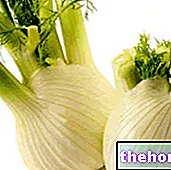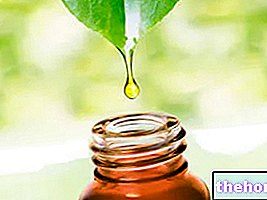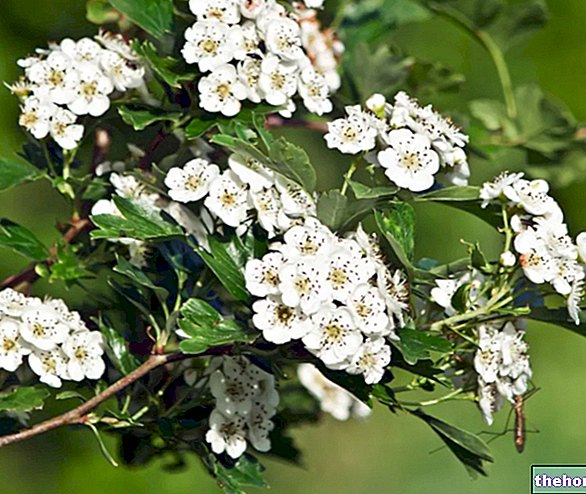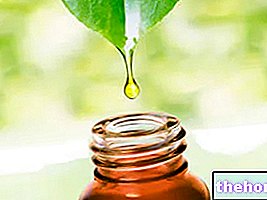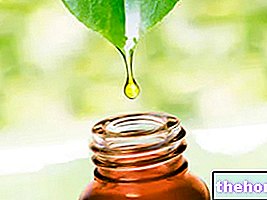Did you mean: Vaginal lavage
Lavandula officinalis Chaix
Lavandula hybrida Rev.
Fam. Lamiaceae (Labiatae)
Br. Lavande and Lavandin
Eng. Lavender and Lavendin
Ted. Lavendel
Sp. Espliego
Description
Genus of suffruttic plants which includes 28 species of temperate zones, of which the main ones are: L.angustifolia, L.vera., L. officinalis, L. stoechas, L. spica, L. latifolia and interspecific hybrids, which are called sinks.
Lavender is about 50 cm high, very branched with erect quadrangular flower stems, small and linear leaves, initially covered with hair, later glabrous.
The blue-violet flowers are small and gathered in terminal inflorescences (spicastri) that bloom in June-July, giving off a characteristic and intense perfume.
The fruit is an achene in lavender, while it is absent in the sink since the plant is a sterile hybrid. Hybrids can be recognized from true lavender by the presence of secondary inflorescences inserted in the armpit of the main stem and by the wider axillary bract of the flowers.

Areal
There are various species of spontaneous lavender that have different distribution areas even if they all refer to the Mediterranean region. The species present at altitudes above 500-600 m s.l.m. And the L.officinalis typical of dry environments and calcareous soils. It is from 50 to 80 cm high and lives spontaneously or naturalized in various mountainous or submontane areas. The species present at altitudes below 500m is L. spica, 40-50 cm high, very sensitive to cold and with a strong camphor smell, L.stoechas, also sensitive to the cold, it adapts well to sandy soils and drought environments.
Generally plants of the genus Lavandula they prefer dry, calcareous and deep soils; they tolerate acid soils poorly while they adapt well to alkaline ones.
They are often used against the erosion of unstable sloping soils.
Hybrids are the object of greater cultivation for the yield of essence and for being plants with greater vegetative development and inflorescence stems of considerable length. Currently the sink is mainly cultivated (L.hybrida Rev.), which is a natural and sterile hybrid of L. officinalis x L. spica.
France, Spain, the former Soviet Union, Bulgaria, Hungary and England are the main cultivation countries. The crop can last 6 or 10 years for lavender and sink respectively. The plant is preferably made from cuttings for both because it is difficult to find genetically homogeneous seeds (for fertile lavender) and because the seed plants are less productive.
The cuttings, usually herbaceous, 12-15 cm long, are taken in autumn or spring from a young 2-year-old plant and are placed in the nursery for rooting, facilitated by the use of hormonal substances. After 1 year, the transplant in rows spaced 1.5-2 m apart (about one plant / m2). Nitrogen-phosphorus and potassium fertilizers (50-60 kg / ha) at the plant and 60-70 kg / ha subsequently are to be carried out in spring
There are various fungi, responsible for root and collar rot, a virus, a nematode, two dipters, which cause necrosis of the stems, beetles and lepidoptera. There Septoria, a fungus that attacks young shoots, can cause serious damage, so it is necessary to control it with 3 applications a year of Bordeaux mixture or other products.
It is good to remember that lavender is a honey plant, so any treatments must be compatible with the needs of bees.
Weeds can be fought with weeding, light however, to avoid damaging the roots which are quite superficial
Harvest and yields
Harvesting begins on 2-year plants with increasing yields over the next 5-6 years; it works with mowing-tying machines that cut off the inflorescences and some herbaceous stem, leaving the woody portions of the plant intactThe product for distillation must not contain leaves because they give the essential oil an unwelcome sour aroma.
The optimal period coincides with the beginning of the withering.
The maximum yield in inflorescences is 5-7 t / ha for lavender, 12-15 for the sink.
The quantity and quality of lavender essence is influenced by various environmental and cultivation factors:
1) 1'altitude it causes a decrease in quantity, but an improvement in quality: the content of linalyl acetate increases and camphor decreases;
2) Fertilization with K increases the presence of camphor, while P and N decrease it. If we exceed with N and P we reduce the essence content;
3) hot winds or rain during flowering they reduce the yield
4) important are the cultivar used.
Drug
It is given by the inflorescences, from which a very precious essence is extracted by steam distillation, often performed in the place where it is collected. The flowers for herbal medicine are collected at the beginning of flowering, while for the cosmetic and perfumery industries in the period of maximum flowering; they are then dried. and distilled. They contain an essential oil with linalyl acetate (30-55%), linalool, cineole and camphor
Uses
In phytotherapy, lavender is used for its antiseptic, vasodilatory, antineuralgic properties in muscular and arthritic pain, sedative in mild states of insomnia or states of agitation.
In cosmetics: it is essentially used to make perfumes.
Other uses: it is a melliferous plant from which precious honeys are obtained, considered suitable for treating bronchopulmonary diseases, such as rheumatic diseases and asthma.
Select plant Fir Acacia Acerola Sorrel Yarrow Yarrow Yarrow Aconito Adatoda Garlic Agnocasto Agrimonia Alchemilla Alkekengi Aloe Altea Witch Hazel Ammi or Visnaga Pineapple Andrographis Anemone Pulsatilla Angelica Anise Star Anise Japanese Star Anise Bitter Orange Bitter Areca Arnica Harpagophytum Arpagophyte Artemisia Asteragus Basil Asparagus Asparagus Peruvian Asparagus Asparagus Asparagus Hawthorn Boldo Borage Shepherd's Purse Boswellia Bucco Butea superba Cocoa Coffee Cajeput Calamus Calamus Marigold Camedrio Chamomile Roman Chamomile Camphor Cinnamon Ceylon Maidenhair Capuchin Artichoke Cardamom Cardiac Thistle Asian Thistle Carvi Cascara Cassia Catecu Catha Cabbage Celandine Chicory Centaurea Cinnamon Cypress Celandine Chives Cypress Coca Cola Colchico Combreto Condurango Comfrey Coriander Cranberry Barberry American Chrysanthemum Cumin Turmeric Damiana Digital Dioscorea Drosera Dulcamara Dunalilella Echinacea Eder a Ephedra Elenio Eleutherococcus Helichrysum Evening primrose Horsetail Alfalfa Erica Euphrasia Erisimo Escolzia Eucalyptus Farfara Farfaraccio Calabar bean Fenugreek Fennel Phytolacca Frangola Ash Fumaria Japanese Mushrooms Galega Ganoderma lucidum Garcinia Cambogia Mulberry Gentian Broom Ginkgo Ginkgo Guipana Guipana Gynestra Ginkgo Hibelia Gymnasium Hibiscus Guarulp St. John's Wort Horse Chestnut Ispaghul Hyssop Jaborandi Kava kava Konjac Laminaria Cherry Laurel Lavender Lemongrass Lespedeza Lovage Icelandic Lichen Lemon Flax Lippia Licorice Lobelia Hops Maca Marjoram Maize Mallow Manna Marrubio Marrubio d "water Matè Melaleuca Meliloto American Lemon balm Myrtle Myrama Walnut Nutmeg Walnut vomica Olive tree Meadowsweet Ononide Opuntia Oregano Orthosiphon Nettle Poppy Papaya Parietaria Feverfew Passiflora Chilli Perilla Periwinkle Phyllanthus Plantain Picrorhiza Pilosella Pino Pisci dia Podofillo Polygala Grapefruit Parsley Psyllium Pueraria mirifica Butcher's broom Pygeum Quassia Oak Rhubarb Ratania Rauwolfia currant Castor bean Rhodiola Rosehip Rosemary Rue Willow Sarsaparilla Sage Elderberry Sassafras Sedum Ergot Senna Serenoa Repens Soybean Solidago Tansy Taraxus Tamarind Tamarind Tamarind Tamarind Tamarindo Ursina Valerian Vanilla Mullein Verbena Veronica Viburnum Vinca Pansy Mistletoe Vine Withania Yohimbe Saffron Ginger Pumpkin Select disease Juvenile Acne Rosacea Tinnitus Tinnitus Aerophagia Tendon Affections Afonia Aphthae Algias Functional Halitosis Breastfeeding Allergy Anemia Anguish Anxiety Arteriosclerosis Asthrosis Asthrosis Arthritis Arthritis Men Sex Woman Blepharitis and Conjunctivitis Eye bags Bronchitis Gallstones Kidney stones Salivary stones Baldness Androgenetic Candida Fragile hair Caries Headache Cellulitis Motion sickness Cystitis C limaterio Cholecystopathy High cholesterol Ulcerative colitis Colonoscopy Contusions Hematoma Convalescence Couperose Depression Dermatitis Diaper dermatitis Diabetes Diarrhea Erectile dysfunction Dyslipidemia Dysmenorrhea Dyspepsia Disturbances of vision Hemorrhoids Epistaxis Herethism Heart disease Fever Fibromyalgia Gastro-intestinal disease Flatulence Hypertension Fibromyalgia Gastrointomnia Jaundice Laryngitis Renal lithiasis Toothache Sore throat Thinness Menopause Meteorism Mononucleosis Alzheimer's disease Crohn's disease Nausea Vomiting Obesity Dark circles Onychomycosis Osteoporosis Dry skin Periarthritis Piorea Low pressure Prostatitis Psoriasis Colds Breast fissures Anal fissures Gastro-nasal rhinitis Senescence Premenstrual Syndrome Sinusitis Quit smoking Overweight Fatty liver Constipation Stomatitis Stress Cough Triglycerides high Ulcer Burns Nails Brittle flashes Heat Warts Dizziness Properties herbal Tanning Abortive adaptogenic Aphrodisiac bittering analgesic anesthetic anorectics analgesic antacid anti-allergic anti-asthmatic Antibiotic catarrh Anticellulitiche anticonvulsant Antidiaforetiche antidiarrheal edematous anthelmintic antiemetic Antiemorroidarie antiphlogistic Antiidrotiche Antinevrotiche Antioxidants antipyretic antirheumatic antiscorbutic Antiseptic antispasmodic anti-uric Aperitive Flavoring Astringent Balsamic Bechiche Capillarotrope Cardiotonic Carminative Cathartic Caustics Healing Cholagogues Choleretic Dyes Decongestants Deodorants Purifying Diaphoretic Cleansers Disinfectants Detoxifiers Thirst quenching Diuretics Exciting Emetics Emmenagogues Emollients Hemostatic Energies Hepatoprotectors Expectorants Eupepticus Moisturisers Galactosensitizers lanti Hypertensive Hypnotic Hypoglycemic Hypotensive Irritants Laxatives Soothing Narcotic Nerves Nutrients Odontalgic Pectoral Purgative Revulsive Remineralizing Refreshing Rubefacient Scialagoghe Sedative Soporifugas Sneezing Stomachic Stomatics Narcotic Vascular Tightenitis

